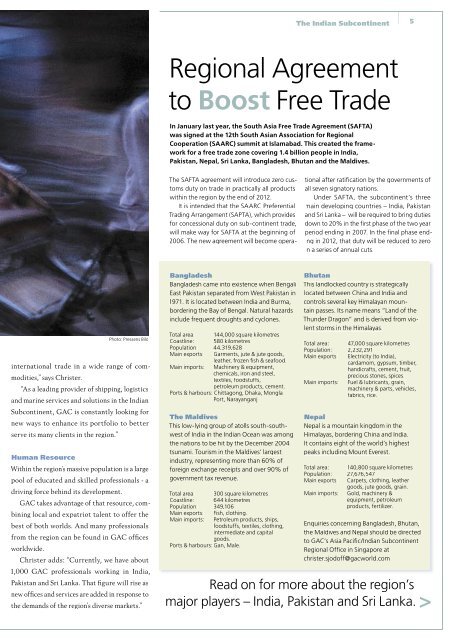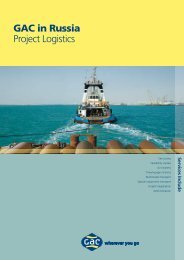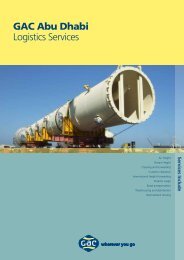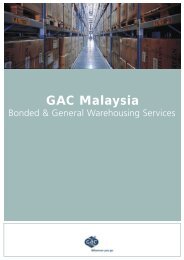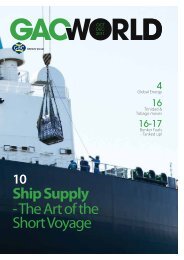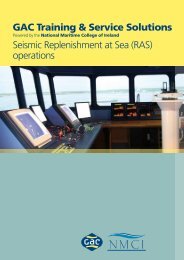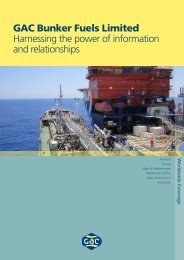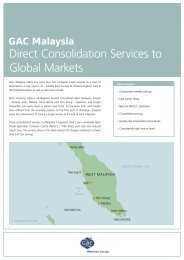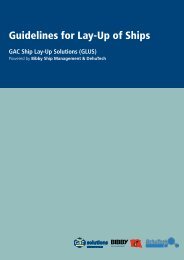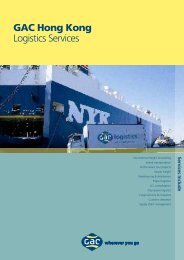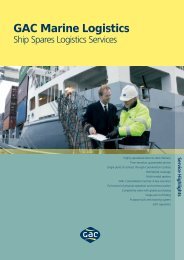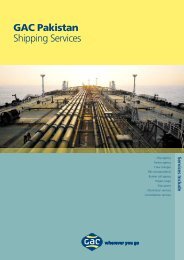You also want an ePaper? Increase the reach of your titles
YUMPU automatically turns print PDFs into web optimized ePapers that Google loves.
international trade in a wide range of com-<br />
modities,” says Christer.<br />
“As a leading provider of shipping, logistics<br />
and marine services and solutions in the Indian<br />
Subcontinent, <strong>GAC</strong> is constantly looking for<br />
new ways to enhance its portfolio to better<br />
serve its many clients in the region.”<br />
Human Resource<br />
Within the region’s massive population is a large<br />
pool of educated and skilled professionals - a<br />
driving force behind its development.<br />
<strong>GAC</strong> takes advantage of that resource, com-<br />
bining local and expatriot talent to offer the<br />
best of both worlds. And many professionals<br />
from the region can be found in <strong>GAC</strong> offi ces<br />
worldwide.<br />
Photo: Pressens Bild<br />
Christer adds: “Currently, we have about<br />
1,000 <strong>GAC</strong> professionals working in India,<br />
Pakistan and Sri Lanka. That fi gure will rise as<br />
new offi ces and services are added in response to<br />
the demands of the region’s diverse markets.”<br />
The Indian Subcontinent<br />
Regional Agreement<br />
to Boost Free Trade<br />
In January last year, the South Asia Free Trade Agreement (SAFTA)<br />
was signed at the 12th South Asian Association for Regional<br />
Cooperation (SAARC) summit at Islamabad. This created the framework<br />
for a free trade zone covering 1.4 billion people in India,<br />
Pakistan, Nepal, Sri Lanka, Bangladesh, Bhutan and the Maldives.<br />
The SAFTA agreement will introduce zero customs<br />
duty on trade in practically all products<br />
within the region by the end of 2012.<br />
It is intended that the SAARC Preferential<br />
Trading Arrangement (SAPTA), which provides<br />
for concessional duty on sub-continent trade,<br />
will make way for SAFTA at the beginning of<br />
2006. The new agreement will become opera-<br />
Bangladesh<br />
Bangladesh came into existence when Bengali<br />
East Pakistan separated from West Pakistan in<br />
1971. It is located between India and Burma,<br />
bordering the Bay of Bengal. Natural hazards<br />
include frequent droughts and cyclones.<br />
Total area: 144,000 square kilometres<br />
Coastline: 580 kilometres<br />
Population: 44,319,628<br />
Main exports: Garments, jute & jute goods,<br />
leather, frozen fi sh & seafood.<br />
Main imports: Machinery & equipment,<br />
chemicals, iron and steel,<br />
textiles, foodstuffs,<br />
petroleum products, cement.<br />
Ports & harbours: Chittagong, Dhaka, Mongla<br />
Port, Narayanganj<br />
The Maldives<br />
This low-lying group of atolls south-southwest<br />
of India in the Indian Ocean was among<br />
the nations to be hit by the December 2004<br />
tsunami. Tourism in the Maldives’ largest<br />
industry, representing more than 60% of<br />
foreign exchange receipts and over 90% of<br />
government tax revenue.<br />
Total area: 300 square kilometres<br />
Coastline: 644 kilometres<br />
Population: 349,106<br />
Main exports: Fish, clothing.<br />
Main imports: Petroleum products, ships,<br />
foodstuffs, textiles, clothing,<br />
intermediate and capital<br />
goods.<br />
Ports & harbours: Gan, Male.<br />
Nepal<br />
Nepal is a mountain kingdom in the<br />
Himala yas, bordering China and India.<br />
It contains eight of the world’s highest<br />
peaks including Mount Everest.<br />
Total area: 140,800 square kilometres<br />
Population: 27,676,547<br />
Main exports: Carpets, clothing, leather<br />
goods, jute goods, grain.<br />
Main imports: Gold, machinery &<br />
equipment, petroleum<br />
products, fertilizer.<br />
5<br />
tional after ratifi cation by the governments of<br />
all seven signatory nations.<br />
Under SAFTA, the subcontinent’s three<br />
main developing countries – India, Pakistan<br />
and Sri Lanka – will be required to bring duties<br />
down to 20% in the fi rst phase of the two year<br />
period ending in 2007. In the fi nal phase ending<br />
in 2012, that duty will be reduced to zero<br />
in a series of annual cuts.<br />
Bhutan<br />
This landlocked country is strategically<br />
located between China and India and<br />
controls several key Himalayan mountain<br />
passes. Its name means “Land of the<br />
Thunder Dragon” and is derived from violent<br />
storms in the Himalayas.<br />
Total area: 47,000 square kilometres<br />
Population: 2,232,291<br />
Main exports: Electricity (to India),<br />
cardamom, gypsum, timber,<br />
handicrafts, cement, fruit,<br />
precious stones, spices.<br />
Main imports: Fuel & lubricants, grain,<br />
machinery & parts, vehicles,<br />
fabrics, rice.<br />
Enquiries concerning Bangladesh, Bhutan,<br />
the Maldives and Nepal should be directed<br />
to <strong>GAC</strong>’s Asia Pacifi c/Indian Subcontinent<br />
Regional Offi ce in Singapore at<br />
christer.sjodoff@gacworld.com<br />
Read on for more about the region’s<br />
major players – India, Pakistan and Sri Lanka. >


